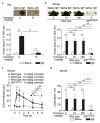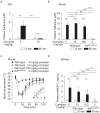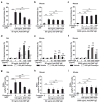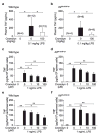Evidence questioning cromolyn's effectiveness and selectivity as a 'mast cell stabilizer' in mice
- PMID: 22906983
- PMCID: PMC3580174
- DOI: 10.1038/labinvest.2012.116
Evidence questioning cromolyn's effectiveness and selectivity as a 'mast cell stabilizer' in mice
Abstract
Cromolyn, widely characterized as a 'mast cell stabilizer', has been used in mice to investigate the biological roles of mast cells in vivo. However, it is not clear to what extent cromolyn can either limit the function of mouse mast cells or influence biological processes in mice independently of effects on mast cells. We confirmed that cromolyn (at 10 mg/kg in vivo or 10-100 μM in vitro) can inhibit IgE-dependent mast cell activation in rats in vivo (measuring Evans blue extravasation in passive cutaneous anaphylaxis (PCA) and increases in plasma histamine in passive systemic anaphylaxis (PSA)) and in vitro (measuring peritoneal mast cell (PMC) β-hexosaminidase release and prostaglandin D(2) synthesis). However, under the conditions tested, cromolyn did not inhibit those mast cell-dependent responses in mice. In mice, cromolyn also failed to inhibit the ear swelling or leukocyte infiltration at sites of PCA. Nor did cromolyn inhibit IgE-independent degranulation of mouse PMCs induced by various stimulators in vitro. At 100 mg/kg, a concentration 10 times higher than that which inhibited PSA in rats, cromolyn significantly inhibited the increases in plasma concentrations of mouse mast cell protease-1 (but not of histamine) during PSA, but had no effect on the reduction in body temperature in this setting. Moreover, this concentration of cromolyn (100 mg/kg) also inhibited LPS-induced TNF production in genetically mast cell-deficient C57BL/6-Kit(W-sh/W-sh) mice in vivo. These results question cromolyn's effectiveness and selectivity as an inhibitor of mast cell activation and mediator release in the mouse.
Conflict of interest statement
The authors state no conflict of interest.
Figures





Similar articles
-
Resveratrol inhibits IgE-mediated basophilic mast cell degranulation and passive cutaneous anaphylaxis in mice.J Nutr. 2013 May;143(5):632-9. doi: 10.3945/jn.112.173302. Epub 2013 Mar 20. J Nutr. 2013. PMID: 23514766
-
A novel model of IgE-mediated passive pulmonary anaphylaxis in rats.PLoS One. 2014 Dec 26;9(12):e116166. doi: 10.1371/journal.pone.0116166. eCollection 2014. PLoS One. 2014. PMID: 25541997 Free PMC article.
-
Effect of disodium cromoglycate on mast cell-mediated immediate-type allergic reactions.Life Sci. 2004 Apr 23;74(23):2877-87. doi: 10.1016/j.lfs.2003.10.026. Life Sci. 2004. PMID: 15050425
-
A comparison of the anti-anaphylactic activities of salbutamol and disodium cromoglycate in the rat, the rat mast cell and in human lung tissue.Br J Pharmacol. 1979 Sep;67(1):23-32. Br J Pharmacol. 1979. PMID: 115530 Free PMC article.
-
Effect of cromolyn sodium and deuterium oxide on anaphylactic histamine release from rat peritoneal mast cells in vitro.J Pharmacol Exp Ther. 1975 Aug;194(2):457-62. J Pharmacol Exp Ther. 1975. PMID: 50438
Cited by
-
Mast cells: versatile gatekeepers of pain.Mol Immunol. 2015 Jan;63(1):38-44. doi: 10.1016/j.molimm.2014.03.001. Epub 2014 Mar 22. Mol Immunol. 2015. PMID: 24666768 Free PMC article. Review.
-
The Role of Mast Cells in Molding the Tumor Microenvironment.Cancer Microenviron. 2015 Dec;8(3):167-76. doi: 10.1007/s12307-014-0152-8. Epub 2014 Sep 7. Cancer Microenviron. 2015. PMID: 25194694 Free PMC article.
-
The novel flavone tetramethoxyluteolin is a potent inhibitor of human mast cells.J Allergy Clin Immunol. 2015 Apr;135(4):1044-1052.e5. doi: 10.1016/j.jaci.2014.10.032. Epub 2014 Dec 10. J Allergy Clin Immunol. 2015. PMID: 25498791 Free PMC article.
-
Anti-allergic cromones inhibit histamine and eicosanoid release from activated human and murine mast cells by releasing Annexin A1.PLoS One. 2013;8(3):e58963. doi: 10.1371/journal.pone.0058963. Epub 2013 Mar 18. PLoS One. 2013. PMID: 23527056 Free PMC article.
-
Mast cell activation mediates blood-brain barrier impairment and cognitive dysfunction in septic mice in a histamine-dependent pathway.Front Immunol. 2023 Feb 1;14:1090288. doi: 10.3389/fimmu.2023.1090288. eCollection 2023. Front Immunol. 2023. PMID: 36817492 Free PMC article.
References
Publication types
MeSH terms
Substances
Grants and funding
LinkOut - more resources
Full Text Sources
Other Literature Sources
Medical
Molecular Biology Databases
Research Materials
Miscellaneous

